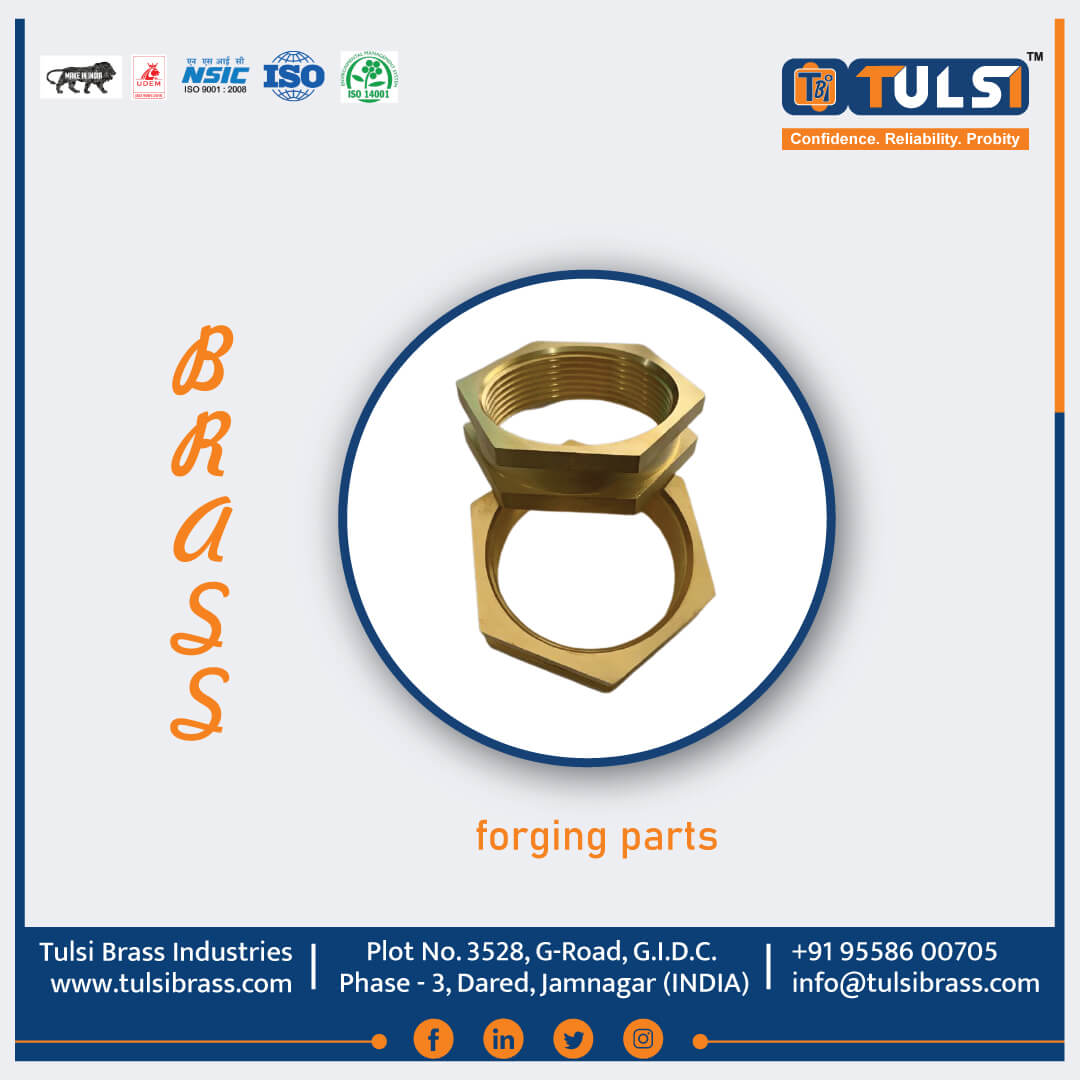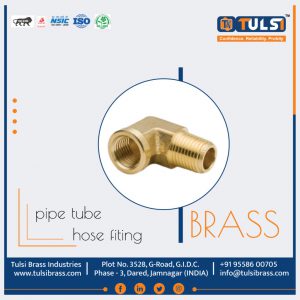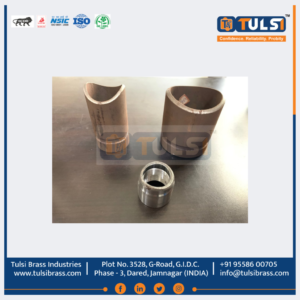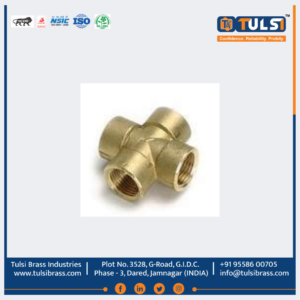- Brass Components
- Brass Pneumatic Fittings
- Brass Forging Components
- Brass Anchors
- Brass Pool Anchors
- Brass Electrical Fittings
- Brass Cable Glands
- Brass Switch Gear Parts
- Brass Sanitary Parts
- Brass Gas Fittings
- Brass Ceramic Cartridge Fittings
- Brass Casting Components
- Brass Billets
- Brass Auto Parts
- Brass Block Meter Parts
- Brass Washers
- Brass Barb Hose Fittings
- Brass Inserts
- Brass Fasteners
- Screws Fasteners

Brass Forging Components
Tulsi Brass Industries takes pride in offering a wide array of Brass Forging Components. Moreover, made from high-quality brass materials, our forging components are meticulously crafted to ensure exceptional strength and durability. Whether you require plain brass, nickel-plated brass, or plastic components, we have a comprehensive range available to meet your specific needs. Additionally, our brass products are designed to deliver reliable performance and withstand the test of time. Furthermore, our commitment to quality ensures that you can trust in the durability and functionality of our Brass Forging Components
Brass Forging Components: High-Quality, Custom-Made Parts for Your Needs
We offer a wide range of applications across numerous industries. Moreover, from automotive and aerospace to plumbing and electronics, these components play a vital role in enhancing performance and reliability. Their ability to withstand high temperatures and pressures makes them an ideal choice for critical applications. Furthermore, invest in brass forged components to elevate the quality and reliability of your products. Experience the unparalleled benefits of brass and unlock a world of possibilities for your projects.
In addition, choose Tulsi Brass Industries for top-quality brass forging parts that meet your specific needs.
Cold forging and hot forging are two common methods that the manufacturing industry uses to shape metal components. While both processes involve deforming metal, they differ in terms of temperature, material properties, and application. Here’s an overview of cold forging and hot forging:
Cold Forging
Firstly, cold forging, also known as cold forming, performs a metalworking process at or near room temperature. Additionally, it shapes metal by applying compressive forces. Furthermore, it typically places the metal in a die and subjects it to high pressure, causing it to take the shape of the die cavity. Notably, manufacturers commonly use cold forging to produce small to medium-sized components with intricate shapes.
Applications of Cold Forging
Industries such as automotive, aerospace, and electronics widely use cold forging. It is suitable for producing fasteners, bolts, screws, and other small components that require high strength and dimensional accuracy. Moreover, it offers cost-effective solutions and enhances production efficiency.
Hot Forging
On the other hand, hot forging involves shaping metal components at elevated temperatures. Specifically, it heats the metal to a specific temperature range, above its recrystallization temperature, to improve its plasticity. Furthermore, it places the metal in a die and subjects it to compressive forces, causing it to take the shape of the die cavity. Consequently, manufacturers commonly use hot forging to produce large components with simple or moderate shapes.
Applications of Hot Forging
Industries such as construction, oil and gas, and power generation commonly use hot forging. It is suitable for producing components such as gears, shafts, and large structural parts that require high strength and toughness. Additionally, it offers advantages such as improved grain structure and enhanced mechanical properties.
In summary, both cold forging and hot forging are effective methods for shaping metal components. To summarize, cold forging is ideal for small to medium-sized components with intricate shapes, while hot forging is suitable for larger components with simpler shapes. In conclusion, the choice between the two processes depends on factors such as component size, shape complexity, material properties, and production volume.
Increased Strength
Firstly, cold forging compacts the metal, resulting in improved mechanical properties such as higher tensile strength and hardness. Additionally, it enhances the overall structural integrity of the components.
Superior Surface Finish
Moreover, cold forged components often have smoother surfaces, reducing the need for additional finishing operations. Consequently, it saves time and resources during the manufacturing process.
Material Savings
Furthermore, cold forging allows for precise shaping, minimizing material waste compared to other manufacturing methods. Notably, this leads to cost savings and efficient utilization of resources.
Cost-Effective
Additionally, cold forging requires less energy and can produce high volumes of components at a faster rate, making it a cost-effective option. Consequently, manufacturers can achieve economies of scale and optimize their production processes.
Enhanced Ductility
Firstly, heating the metal increases its plasticity, allowing for easier deformation and shaping. Consequently, it enhances the overall ductility of the metal, making it more malleable and flexible.
Reduced Material Strain
Moreover, hot forging minimizes the risk of material cracking or failure during the deformation process. Additionally, the elevated temperature improves the metal’s ability to withstand the forces applied during forging, reducing the strain on the material.
Improved Grain Structure
Furthermore, the heat used in hot forging refines the metal’s grain structure, resulting in enhanced mechanical properties. Specifically, it promotes the formation of finer and more uniform grain boundaries, leading to improved strength, toughness, and fatigue resistance.
Versatility
Additionally, hot forging is suitable for a wide range of metals, including steel, aluminum, and titanium. Notably, it offers versatility in terms of the materials that can be effectively forged, expanding the possibilities for various industries and applications.
- Brass Forged Adapter
- Forging Reducing Elbow
- Forging Air Conditioner Brass Fittings & Brass Body
- Electrical & Engineering Industries
- Forged Reducer
- Forged Gas Components
- Brass Forged Fittings
- Forged Immersion Components
- Forged Valve
- Forged Tee
- Forged Automotive Components
- Forged Agricultural Components
- Water & Valve Fittings
- Aerospace
- Automotive
- Construction
- Energy
- Machinery
- Medical
- Oil and gas
- Power generation
We are a manufacturer and exporter of Welded outlet fittings, including brass welded outlets, stainless steel welded outlets, carbon steel welded outlets, alloy steel welded outlets, copper welded outlets, duplex welded outlets, and more. These fittings are produced using the Hot Forging Process, which ensures high-quality and durable products. Our steel welded outlets are widely acclaimed for their superior quality and performance. Additionally, we offer these welded outlets at the most reasonable rates, providing cost-effective solutions for our customers.
We are a leading Manufacturer & Exporter of Forged Brass Ball Valve. It is manufactured making use of supreme quality of raw materials. We make it available in different Specifications at request of customers. It’s dimensional accuracy, precise design and easy operability make it suitable for different purposes in various industries.
- Material – Full Brass Forged Body. (Nickel plated)
- Seat ring – Virgin PTFE (Teflon).
- Lever – Dacromet coated steel handle.
- Spindle – Blow out proof.
- Ball – Super finished chrome plated
- End threads – BSP to ISO 228 at both ends.
- Temp. Working – 20 to 180 degree C.
- Pressure rating – 25 Bar (at 60 degree C).
Brass is a metal alloy that is always made with a combination of Copper and zinc. By varying the amount of copper and zinc, brass can be made harder or softer. other metals—such as aluminum, lead, and arsenic—may be used as alloying agents to improve Machinability and corrosion resistance. list of different grade as mention below.
Free Cutting Brass Rods:
- B 16 C 38500
- BS 2874 CZ – 121Pb3 or CZ124
- C 36000
- IS319 Grade I/ II/ III
- JIS3250 H C3604 or C3602
Forging Brass Rods:
- ASTM B 124 C37700
- BS 2874 CZ 122
- IS 3488 Forging Brass
Riveting Brass Rods:
- IS 4170 CuZn40
- BS 2874 CZ109
- JIS 3250 H C2800
- ASTM B171 C 36500
- IS 4413 CuZn37
- BS 2872 CZ108
Naval Brass Rods:
- IS291 Grade I or II
- BS 2874 CZ 112
- JIS 3250 C4622
- ASTM C48200
Electrolytic-Tough-Pitch (ETP Coppper): ETP is the most common copper. It is universal for electrical applications. ETP has a minimum conductivity rating of 100% IACS and is required to be 99.9% pure. It has 0.02% to 0.04% oxygen content (typical).
Deoxidized High Phosphorus (DHP): Deoxidized High Phosphorus (DHP) is commercially pure copper, which has been deoxidized with phosphorus, leaving relatively high residual phosphorus content. Copper alloy 122 is not susceptible to hydrogen embrittlement, but has relatively low electrical conductivity due to the amount of phosphorous content.
TULSI BRASS INDUSTRIES provides a customized labeling on products packaging, ensuring that each package is tailored to meet customer specifications. Moreover, we offer different packing options to optimize handling and storage efficiency, utilizing standard size wooden pallets.
First and foremost, when it comes to packaging our Brass Forging Components or Parts, we offer flexibility based on the size of the parts. They can be packaged in either a carton or a wooden box. In addition, the outer package prominently displays the brand name and type number. Additionally, we understand that retail packages may have unique requirements, and customers may prefer the use of plastic bags, cartons, or plastic boxes. Consequently, we accommodate these specific packaging requests, including the inclusion of a barcode for easy identification.
During ocean transportation, we prioritize the careful preparation of the package. Notably, we select suitable wooden, steel, or plastic pallets and ensure they are securely wrapped with a plastic sheet and sealed with metal strips. Moreover, the size of the boxes is determined by customer preferences, taking into account factors such as weight per box and handling capabilities.
To facilitate smooth and efficient transport, our packaging is always labeled. Furthermore, the labels prominently display essential information, including the quantity, net weight, gross weight, specific products, and the name of the producer. Consequently, this ensures proper identification and tracking throughout the transportation process.
Port of Dispatch : ICD Khodiyar- Ahmedabad, Mundra port, Nahava Sheva Port – Mumbai, Air Cargo Complex – Ahmedabad, BOM Air Cargo Complex – Mumbai etc.
Payment: 30% advance and rest of against T/T at sight against copy of B/L.



